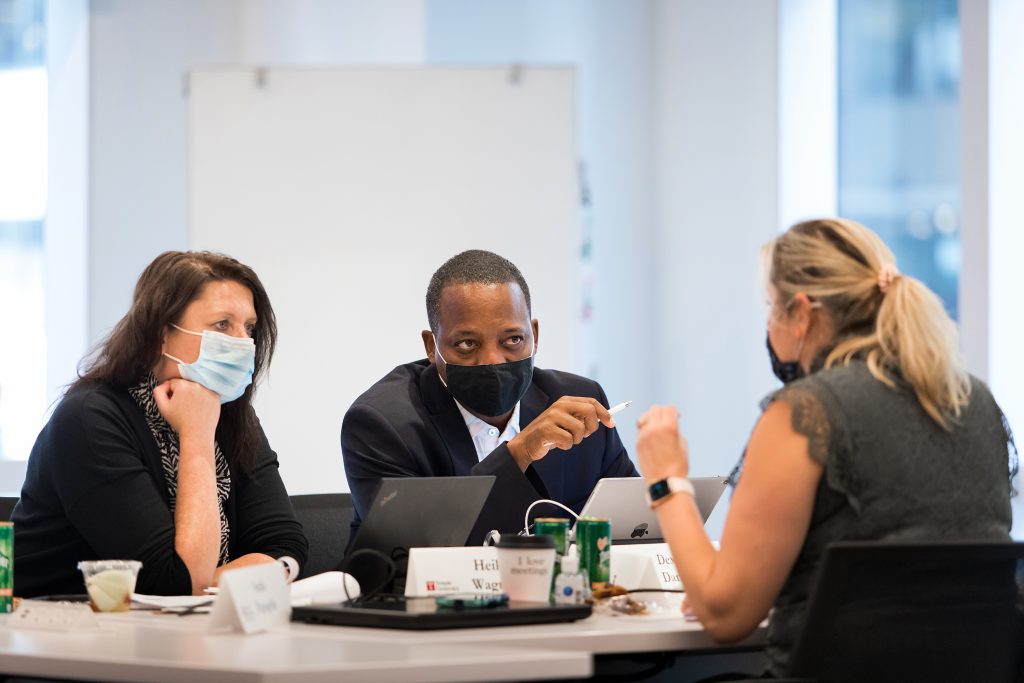Teachers often use real-life examples to make lessons stick in the minds of students. TL Hill, professor of strategic management at the Fox School, was looking for a teaching case that would help students work through a difficult problem: How do you measure and document impact in the nonprofit world? When he couldn’t find one, he decided to write his own.
Teaming up with Lynne Andersson, associate professor of human resource management, Fox alumna Rebecca DeWhitt, MBA ’18, and Temple graduate Claire Thanh Tran, Hill decided to write a case on a project with which he was familiar: the Inside-Out Prison Exchange. The program, founded by Temple criminal justice Professor Lori Pompa, connects and trains educators all over the world to teach university-level courses inside prisons to both incarcerated individuals and university students.
“So often, prison education—which in general is very effective—runs afoul of funding,” says Hill. In order to get funding, nonprofits often have to be able to demonstrate their impact, and Inside-Out was no exception.
Thus, Hill and Andersson had all the makings of a great case study: a business problem, a good story, a relationship and a classroom need.
Case studies have recently taken the spotlight at the Fox School, thanks in part to the Translational Research Center and its case-writing workshops. On the continuum of learning, case studies provide an opportunity to teach critical thinking with real-world problems that have been worked through by experts in their field.
“When I need an example, I tend to grab the latest scandal from The New York Times, like Facebook stealing personal information,” says Andersson. “I like to focus on what’s hot at the time and build out a stakeholder analysis from it. That’s kind of an informal case, but there’s no teaching note; no decision point.”
Teaching cases rely on decision points, a critical moment in an organization’s history that dramatizes useful ideas and tools. These decision points provide the opportunity for students to apply and internalize what they are learning. Working as consultants, students have to defend their choice and match it up against the results of the case. In other words, they are perfect for students who have a grasp of the basics but are not ready for a live problem.
As Hill explains, “Cases are ambiguous, but we know the answer, and they’re low stakes. They offer a great way to learn critical thinking about pressing managerial issues but in a supportive setting.”
As a program, Inside-Out enables educators to bring the classroom into the prison, carving out a unique space for incarcerated individuals and traditional undergraduates to learn side-by-side. In Hill and Andersson’s case, students are led to discover the program’s many stakeholders and how the experience affects their lives.
One of the biggest lessons that the program learned from being the subject of a business case is to have a more concerted effort to collect data that can be translated into a measure of impact. But their teaching case, a problem frozen in a particular time and context, can help educators like Hill give their students a bit of practice for the real world.
Hill recalls a colleague saying, “‘Cases are cadavers, and we like to work with living problems.’ But just like in medicine, cadavers can be very useful in an instructional setting.”
Tips for Teachers: Using Cases in the Classroom
Get students engaged with practical issues through business cases. Neha Mittal, associate professor and strategic outreach director for the Translational Research Center, offered these tips for using cases effectively in the classroom.
1) Share Early
Make the case available to the students in advance. Quiz them with relevant questions from the case study to start them thinking about the problem.
2) Use a Video
Find a short video on the case or the featured company to get students engaged and interested in the case discussion right away.
3) Meet the Subject
If possible, invite the case protagonist to the classroom. Hearing the real-life story is authentic, enriching and fulfilling for the student experience.
4) Play a Role
Divide the class into teams. Each team assumes the role of one stakeholder. Students can consider the benefits, costs and risks that certain decisions present to that stakeholder.
